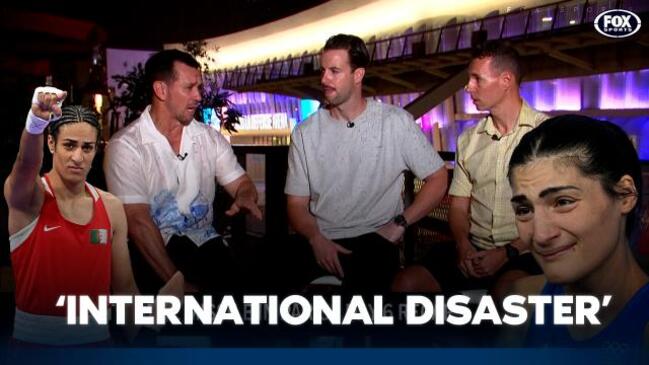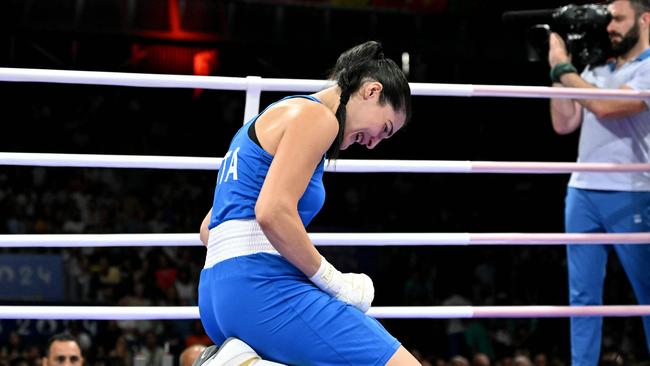IOC categorically rule out gender testing for boxers at the Paris Olympics
Boxing rules will not change during the Paris Olympics and there will be no gender testing, putting female fighters at risk of further injuries amid the Imane Khelif eligibility scandal.

Boxing rules will not change during the Paris Olympics and there will be no gender testing, putting female fighters at risk of further injuries amid the Imane Khelif eligibility scandal.
International Olympic Committee spokesman Mark Adams said the rules at boxing will remain the same for the rest of the Paris competition in the wake of Khelif’s 46-second belting of Italy’s Angela Carini on Thursday.
He claimed “no-one” wanted a reintroduction of the “pretty disgraceful” gender testing for the women’s competitions.
The biological firestorm raged as current Australian Olympic boxer Tiana Echegaray also spoke out on the issue, saying she would refuse to fight a man in the ring.
Adams insisted the two boxers - Algerian Khelif and Chinese Taipei’s Lin Yu-Ting - were “women” because they were classified as females on their passports and they had grown up as women.

But instead of having tests to clarify the issue, he questioned if the two tests conducted by the International Boxing Association were executed properly.
The IBA tests, which disqualified the duo from last year’s world championships, found the two had failed the eligibility to compete as women, with an official saying they had XY chromosomes.
“The IBA disqualified them for that (result), we don't know the protocol, if its accurate or whether to believe the tests,’’ Adams said.
He backtracked on official information originally provided on the Olympic website stating one of the boxers, Khelif, had elevated testosterone levels.
The IOC refuses to hear the safety concerns of the female boxers that they are possibly fighting against boxers with XY chromosomes.
Australian boxing captain Caitlin Parker on Wednesday called for athletes with “differences in sexual development” (DSD) to be banned from fighting against women.

While they have shown much compassion for the two boxers who are the subject of the controversy, it wasn’t until Friday that IOC officials grudgingly referred to the consequences of their rules: the facial injuries Carini sustained during her loss to Khelif.
“Of course we don’t like to see injuries to any athlete and we hope she makes a full and good recovery,’’ Adams said.
Echegaray, who fought for Australia on Tuesday, said she didn’t have a full understanding of the Khelif saga, but would not jump into the ring against a fighter with the XY chromosome.
“It’s really tricky,” he said.
“I don’t know exactly what their circumstances are. I think it’s a case-by-case situation.
“If you are talking about fighting an actual man, then no, I wouldn’t fight a man.
“But in their case I can’t say specifically about them (Khelif and Yu-Ting) because I don’t know their situation.”

Adams said the Olympic Movement tried to balance between inclusivity and fairness and more broadly safety, saying “that is a difficult one’’.
“It is impossible to have a sex test that is comprehensive and works and is not discriminatory,’’ he said.
He said there had been a lot of misinformation which was emotionally damaging to the two boxers and urged that the culture wars are taken out of the debate.
Australian Olympian Marissa Williamson Pohlman, who lost her bout on Thursday at North Paris Arena, has previously fought Khelif. She lost to the Algerian at the Eindhoven Cup final in May and believes DSD athletes should be excluded.
“The way I like to explain it is if you have a disability, the natural consequence of having a disability is it’s unfortunate that you can’t compete,” she said.
“That’s another natural consequence of having this issue that you have to live your life with.
“You can’t put other people at risk.
“In boxing you don’t feel safe at all, it’s the sport. You are getting punched in the head, it’s unsafe as it is.
“I was talking to track and field athletes about it and in track and field, it’s a different story, you are running in a straight line and that’s it.
“In the boxing arena, you are throwing punches at someone’s head and you are trying to hurt them, so that’s the difference.”





